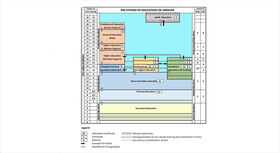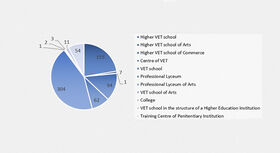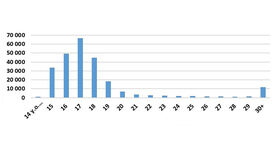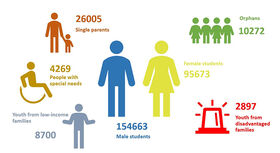Vocational education and training in Ukraine: A system in transition
Guest article by Snizhana Leu-Severynenko, PhD (Independent Education Expert, Kyiv)
In Ukraine, vocational education and training has been in a state of flux for several years - dual elements have also been integrated into training. In a guest article, vocational training expert Snizhana Leu-Severynenko looks at developments, structures and data on the Ukrainian VET system.

The system of vocational education in Ukraine ensures the provision of knowledge and skills in a wide range of vocational education degrees. The Ukrainian vocational education system also includes some elements of dual education. However, entry into vocational education is through a vocational school, where, among other things, students have the option of choosing the dual practice-oriented form of vocational education. Vocational students then undergo training that is more efficiently focused on applied learning. After successfully completing vocational training, a person can work as an assistant, skilled worker, advanced worker or specialist.
Brain drain leads to pressure for innovation
While the image of industrial occupations is poor, the labor market reports a shortage of vocationally qualified individuals. The “hunger for a skilled workforce” for the economy of Ukraine became especially evident in 2015 when the work-migration of the Ukrainians to the EU countries significantly increased. The impact of this exodus was clearly visible: on the one hand, local employers improved the working conditions on-site in order to retain workers. On the other hand, the outflow prompted VET and business/industry representatives to reach out to each other and take active steps on how to align VET with labour market needs. Therefore, recently, there have been more and more cases of cooperation between VET and enterprises, of public-private partnerships, and of joint activities to improve VET content through the development of professional (vocational) and pedagogical standards in the VET sector in Ukraine.
The Ukrainain VET system in a nutshell

The Ukrainian VET system covers three levels of training: an initial, a basic, and an upper level. The levels refer to the 2nd, 3rd, 4th and 5th levels of the Ukrainian National Qualification Framework (NQF) accordingly, and correspond with the 3rd, 4th and 5th levels of the European Qualification Framework (EQF).
- The first (initial) level is dedicated to active career guidance and covers the needs in VET for secondary school students, orphans or children aged 12-13 from low-income families. Secondary school students (especially those attending the higher levels) can acquire vocational skills in extracurricular training courses. Orphans and children from low-income families can study at a VET school from grade 7 and have free food and accommodation at the school.
- The most widespread and popular level is the secondary (basic) level. It can be attended after completing grade 9 (14-15 years) or grade 11 (16-18 years) of a secondary school. When a young person enters the basic level after grade 9, he or she goes through a three to four-year programme that includes the full programme of secondary education as well as vocational qualifications. The training period can be extended to acquire up to four vocational specialisations. The same mechanism applies to young people who enter the basic level after completing grade 11. In this case, the training lasts between one and two years.
- The Third (upper) level serves the upskilling and re-skilling needs of adults. For this purpose, the adults can use the training services of training providers of different types e.g. VET schools, training centres at enterprises and private ones. The elder students (adults) can get a new qualification or upskill their professional level through individual educational pathways or a day, part-time and extra-mural education, or dual form of training. The term of the training time is up to the level of qualification that a person has and the desired professional development level. So, it can take from three months to 3 years.
VET in Ukraine is free, as VET schools offer free accommodation and scholarships for their students. However, these are small and not enough to pay the bills. Therefore, most students pursue a part-time job alongside their studies or opt for dual or dualised training to earn a higher income. The training ends with a certificate or diploma as a skilled (qualified) worker or with a professional junior bachelor's degree (фаховий молодший бакалавр) after graduation from a professional college. The certificates entitle the holder to enter the labour market or to study at a higher education institution.
College education in Ukraine belongs to the so-called "professional pre-higher education", which is at NQF and EQF levels 3-5 (GoU). It can be completed after 9th or 11th grade, and the time calculation for the education cycle is the same as for VET. Students with experience from grade 11 need 2-3 years to obtain the diploma of a junior specialist. Colleges are not as autonomous as VET schools and mostly serve as structural subdivisions of universities.
Types of VET institutions

As of January 1, 2022, there are 694 VET institutions (VET schools) in Ukraine where 685 are under the umbrella of the Ministry of Education and Science of Ukraine (MoES) and 9 ones belong to other Ministries. Most of VET schools are located in Dnipropetrovsk region (57), Lviv region (53) and Donetsk region (43) and the most popular regions for VET students are Lviv (21166), Dnipropetrovsk (20994), and Kharkiv (13867) regions. Traditionally, VET schools were under the regulatory control of the Ukrainian government (GoU). Under decentralisation, which has been increasingly implemented since 2016, MoES now supports the transfer of the VET schools’ property from the state to municipalities (e.g. 257 VET schools were transferred to municipal ownership in 2021). This is crucial for the development of the regions, as they want to cover VET expenditure from their budgets and use VET resources to meet their development needs with as few bureaucratic procedures as possible.
Currently, there are different types of VET institutions, e.g. vocational schools, higher VET schools, vocational lyceums, VET centres and some other types. They offer different VET programmes at different levels of VET. The ongoing reform process aims to reduce the number of VET institutions to three to four types (e.g. VET lyceum, VET school, VET centre and Workers' Vocational Development Centre) in order to allow for better understanding and improve the image of the VET system.
Age of VET students

As the Ukrainian VET system is school-based, links to employers are established through dualised forms of education and training, internship programmes and the work of practical training centres (TPC) at VET schools. TPCs provide a modern technical infrastructure for the training of vocational students, for the further education and retraining of adults and for the employees of local enterprises. VET schools can establish or expand TPCs by attracting funding from local budgets, special funds, local enterprises and national and international companies. In the last 5 years, MoES has invested UAH 350 million (over 11 mln Euros) for 194 TPCs in Ukraine.
As of 01 January 2022, 250,336 thousand people were in VET. The average age is 17 years (66,637).
170,886 thousand students have entered a vocational school after 9th grade, where they acquire a double qualification (secondary school diploma plus vocational qualification) at the basic level. They acquire vocational qualifications for various sectors of the economy in Ukraine. According to statistical data, in 2021, 89,996 out of 110,212 graduates of VET schools found a job according to their vocational qualification in the sectors of industry (26,940), agriculture (11,376), transport (14,695), communications (397), construction (9,937), trade and catering (18,407), housing and utilities (8,244). The rest of the 2021 VET graduates continued their education (7,861), were called up for military service (1,741) or did not find work (10,614) (SES).
Gender and social aspects of VET students

The gender aspect of VET states that VET is more popular among male students, but teaching staff are predominantly female (18,677 out of 31,324). The Ministry of Labour has used the hashtag #пояснюємопрофесії (we explain occupations) on social media to provide detailed information about each occupation and profession to interested people of different genders and ages. The VET system is inclusive and provides knowledge and skills for young people of different categories, such as orphans (10,272) and single parents (26,005), young people from disadvantaged (2,897) and low-income families (8,700), and people with special needs (4,269).
Government of Ukraine. 2019. The Law of Ukraine on the Professional Pre-higher Education
Government of Ukraine. 2022. The Law on Vocational Education and Training
Ministry of Education and Science of Ukraine. 2022. Education
Ministry of Education and Science of Ukraine. 2022. #пояснюємопрофесії (Facebook-Site)
Ministry of Education and Science of Ukraine. 2022. Vocational Education and Training
State Statistics Service. 2022. Demographic and social statistics /Education
World Bank Group. 2019. Review of the Education Sector in Ukraine: Moving toward Effectiveness, Equity and Efficiency. World Bank, Washington, DC (License: CC BY 3.0 IGO)